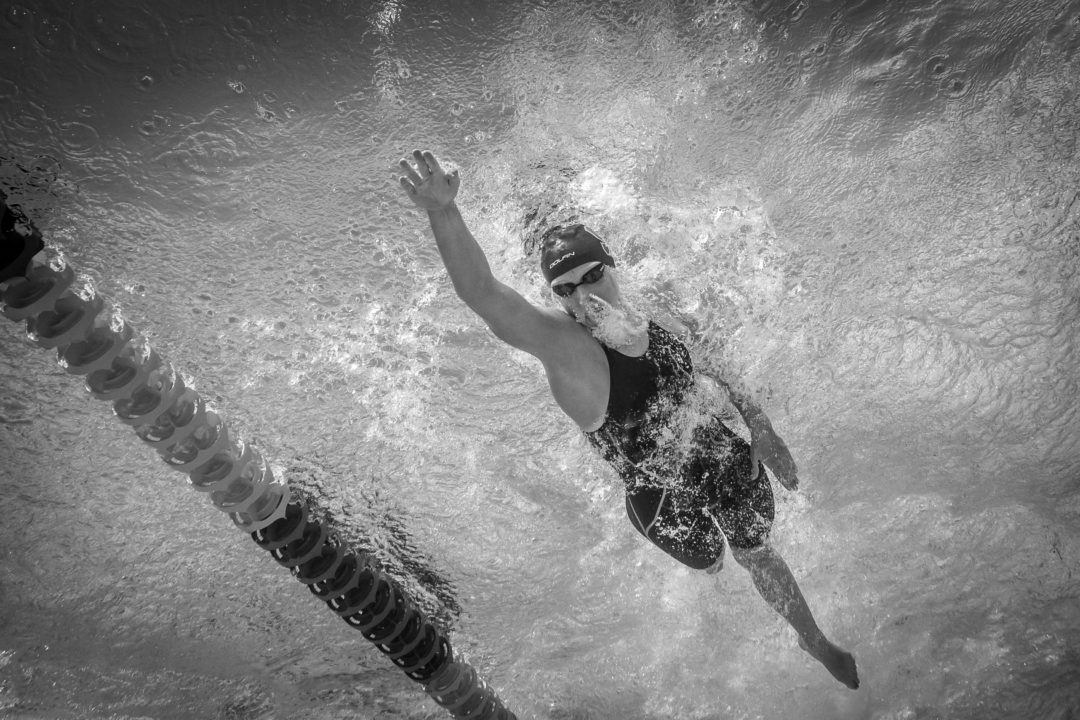Courtesy of Gary Hall Sr., 10-time World Record Holder, 3-time Olympian, 1976 Olympic Games US Flagbearer and The Race Club co-founder.
Acquiring the capability to kick freestyle fast requires that a swimmer develop three crucial abilities:
- Extraordinary ankle plantar flexion
- Leg and core strength for the hip flexors, hip extenders, and knee extenders with the correct biomechanics
- Tremendous stamina to sustain very fast leg motions for an extended period
(Although having big feet is an advantage, it is not an essential requirement of fast kicking.)
This week in our Race Club video release, we feature a new competitive swimmer, Marc Clayton, who is trying to conquer the art of kicking fast. Like many new swimmers, Marc has poor ankle plantar flexibility. To compensate for his lack of ankle flexibility, Marc utilizes a huge knee bend on every third down kick, trying to gain more propulsion in that way.
Bending the knees is essential to get the propulsion needed during the down kick in freestyle. Over-bending the knees leads to tremendous deceleration or slowing down before the down kick. The slowing from the excessive knee bend is not compensated enough by the acceleration from the ensuing hard down kick. The considerable variation in speed from slow to fast caused by the knee bend does not take advantage of the law of inertia. Overbending the knees in freestyle or dolphin kick leads to a slower, inefficient kick.
The ideal knee bend in freestyle and dolphin kick ranges from around 55-75 degrees. Bending the knee less than 55 degrees does not enable the swimmer to generate enough propulsion on the down kick. Bending the knees more than 75 degrees seems to do more harm than good. On the surface, less harm (less drag with the foot in the air) is caused by the knee bend than occurs underwater. Although some swimmers can reduce the drag caused by bending the knees in dolphin kick by dropping the upper leg deeper in the water (flexing at the hip) prior the down kick, in freestyle kick, we have found (using velocity meter technology) that bending the knees past 65-75 degrees is generally not a good technique.
A fast kick begins with developing great plantar flexibility in the ankles. To improve ankle plantar flexibility is not as challenging as one would think. In fact, with a few key stretches done daily, which we will feature in an upcoming video, the plantar flexibility and inversion (pigeon-toeing) of the ankle can improve significantly in a matter of days or weeks.
To prevent the swimmer’s knees’ overbending and improve the kicking mechanics, we employ two important pieces of the equipment- the elastic band (Finis) and the Kick Trainer Cordz (Stretch Cordz). The elastic band is placed around both legs, below the knees, which helps keep the kicking motion tighter. The Kick Trainer is more complicated and requires a few minutes to put on. We always use it with fins on. The Kick Trainer’s elastic cords, attached to the ankles and opposite shoulders above, apply more load to the down kick and help prevent the overbending of the knees. Both tools help us teach the proper kicking biomechanics for freestyle.
Finally, to kick fast, there is no substitute for lots of kicking training in the water. If we ask our legs to contribute a lot to our speed during races, then we need to have the tools to make them generate propulsion- ankle flexibility, leg and core strength, and stamina. Considering that the stroke rate of the legs for a hundred freestyle is roughly 600 kicks per minute, the legs need to be relatively more fit than the arms. Train your kicking legs hard and often. Simultaneously, add the ankle stretches and leg strength work, and you will start to see your kicking times improve dramatically.
Yours in swimming,
Gary Sr.
Like The Race Club on Facebook
Follow The Race Club on Instagram
Follow The Race Club on Twitter
Connect to The Race Club / Gary Hall Sr. on Linkedin
THE RACE CLUB
Because Life is Worth Swimming, our mission is to promote swimming through sport, lifelong enjoyment, and good health benefits. Our objective is for each member of and each participant in The Race Club to improve his or her swimming performances, health, and self-esteem through our educational programs, services and creativity. We strive to help each member of The Race Club overcome challenges and reach his or her individual life goals.
The Race Club provides facilities, coaching, training, technical instruction, video, fitness and health programs for swimmers of all ages and abilities. Race Club swim camps are designed and tailored to satisfy each swimmer’s needs, whether one is trying to reach the Olympic Games or simply improve one’s fitness. Our programs are suitable for beginner swimmers, pleasure swimmers, fitness swimmers, USA swimming or YMCA swimmers, or triathletes; anyone who wants to improve swimming skills. All of our Race Club members share an enjoyment of being in the water and use swimming to stimulate a more active mind and body.


